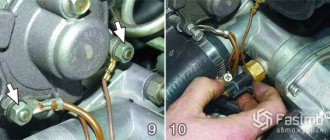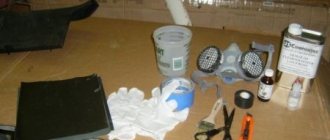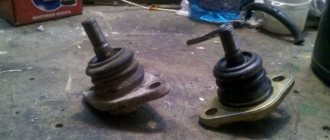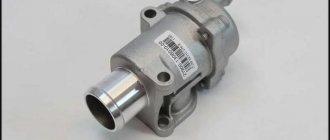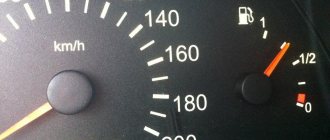The VAZ 21102 version is one of the modifications of the legendary Lada “Ten”. The main distinguishing feature is the 1.5-liter 8-valve injection engine, used for the first time in the line. Therefore, when choosing a modification of the VAZ 2110, the consumer wonders whether it is worth overpaying for the more expensive 16-valve engine of the next version 21103. Some say that it is worth it, because the dynamics of the car are improving. Another part of buyers is inclined to believe that eight valves are enough for the city, the main thing is that there is an injector, and the VAZ 21102 is the best option for purchase.
Family of passenger cars Lada - 110 (VAZ-2110/11/12)
VAZ-2110 is a new generation front-wheel drive car with a sedan body produced by the Volzhsky Automobile Plant.
The car began to be produced serially in 1996. The “tenth” family from Tolyatti, designed almost from scratch, has become a new word in the domestic automotive industry. Compared to previous VAZ 10 models, it is distinguished by a modern interior design, good aerodynamics, a spacious luggage compartment (480 liters) with wide transformation capabilities, and a high degree of maintainability. The VAZ-2110 car also included technical original developments: the use of galvanized metal for body parts that are most susceptible to corrosion, the windshield, rear and rear side windows are glued into the body, the hood is mounted on gas struts, an adjustable steering column, an on-board control system, an immobilizer, a gasoline vapor recovery system, ventilated brake discs and a number of other innovations. The VAZ-2110 is equipped with an automatic heater control system that automatically maintains the set temperature in the cabin and allows the car to be equipped with air conditioning. The “Ten” was initially equipped only with short-stroke carburetor 1.5-liter 69-horsepower VAZ-21083 engines. Then the carburetor engine gave way under the hood to a new generation of engines with distributed fuel injection and electronic control.
The model with an 8-valve 79-horsepower engine with a displacement of 1.5 liters and distributed fuel injection has the VAZ 21102 index. The maximum speed of such a car reaches 167 km/h, and acceleration to “hundreds” takes 14 seconds. Based on this engine, a 16-valve version with a 1.5-liter gasoline engine was also developed. 94 hp VAZ-21103, with a twin-shaft cylinder head, allowing the car to have improved dynamic qualities. The maximum speed of this car is already 180 km/h, and acceleration to “hundreds” takes only 12.5 seconds. There is also a combat 240-horsepower VAZ-21107 “Rally” 2.0V16 with a special tubular safety cage built into the body. Its maximum speed is 220 km/h, and the acceleration time to 100 km/h takes only 7 seconds. But they make it individually, only according to the orders of athletes, and it costs the same as foreign rally cars. Since October 4, 2004, cars of the LADA 110 family have been produced with a new power unit (engines with a displacement of 1.6 liters, 8 and 16 valve options). The service life of the new engine has been increased by 20,000 km compared to its predecessor with a displacement of 1.5 liters. Technical characteristics have noticeably improved. The rated engine power has increased. The 8-valve version of the engine with a displacement of 1.6 liters, which is installed on VAZ-21101 model cars, has an engine power of 82 hp. At the same time, the maximum speed of the car increased to 170 km/h, and the acceleration time to 100 km/h decreased to 13.5 seconds.
The VAZ-21104 model, equipped with a 98-horsepower 16-valve engine with a displacement of 1.6 liters, has a maximum speed of 185 km/h, and acceleration to “hundreds” is 12 seconds. The following modifications of the “Tens” version are provided – “standard”, “norm” and “luxury”. In addition to the standard equipment, the “norm” includes electric windows on the front doors, athermal windows, and headrests in the rear seat. Cars in the “luxury” configuration are additionally equipped with 14-inch alloy wheels, an on-board computer, velor seat upholstery, a heated front seat system, fog lights and a spoiler, with the body painted with metallic enamels. Due to tightened environmental standards, all VAZ 2110 cars have been equipped with a catalyst since 2005.
In the “ten” model range there are two modified models - the VAZ-21103M and VAZ-21104M. They are equipped with a 16-valve engine with a displacement of 1.5 and 1.6 liters, respectively. Externally, these models have a more modern, interesting design. The hood is integrated with the radiator grille, the wings and bumper are modified, and there are plastic trims on the doors and sills. The car interior is more modern and comfortable, the seats are upholstered in velor. Euro doors with standard places for buttons for electric windows and speakers are installed. The package includes electric windows on all doors. Thanks to these changes, the ride in this car will be as comfortable as possible.
The VAZ 2110 with a modern interior design and good aerodynamic performance, adapted to our climatic conditions, is perfect for heavy city traffic.
The model was discontinued at the Volzhsky Automobile Plant in 2007. It was replaced by the LADA Priora.
The materials in this section were obtained from open sources and published for informational purposes. In case of unknowing copyright infringement, the information will be removed after receiving a corresponding request from the authors or publishers in writing.
Interior
When starting to create the interior, the designers took into account some of the shortcomings of previous models and corrected them. Now the driver sits behind the wheel with his legs extended, and not as before, with his legs bent. The steering wheel itself has also changed its appearance, it has become much more beautiful. It has two points of support for the hands with a pillow, and it no longer blocks the visibility of the instruments. The designers have used soft plastic in the dashboard, which looks beautiful and feels good to the touch.
Thanks to this, the likelihood of any noise and squeaks is reduced. In new models, all large mechanical buttons are located on the sides of the dashboard. Climate control is intuitive.
The steering column has the ability to adjust the angle of vertical tilt and has a hydraulic booster. But, despite the updated steering wheel, its rim itself seems too thin to most. The rear seats are quite comfortable, but for three passengers it will already be a bit cramped. The luggage compartment has a volume of 480 liters.
The “Norma” package has front electric windows (it doesn’t matter whether there is a servo drive or not, they do not fully lower into the door), velor upholstery for seats and doors, as well as headrests on the rear sofa. The most expensive “Lux” configuration already has an on-board computer, heated rear-view mirrors and heated seats installed in the front.
The keys installed on the sides of the instrument panel make it impossible to forget that the car began to be designed back in the 1980s. Fuses and relays for the most important options of the car are located inside the car, on the left side under the steering wheel, which is very convenient.
In the famous “Samara” everything was not so convenient. We thought about loading narrow, long things - for this, the middle back of the rear sofa can be fully reclined, and the backs of the rear seats can also be reclined, but at a smaller angle.
Despite the still fairly limited space inside the car, updates to the front fascia and other elements have had a positive impact on the ergonomics of the cabin, which in turn has encouraged many consumers to buy the 2110.
The outside door handle is much better. The tongue from the famous “eight” disappeared, and now the door began to open by simply moving the lever up. Speaking about the doorway, it is worth saying that it has become quite convenient based on the width, but it is too small in height. Not to say that this will interfere, but the lack of headroom is noticeable.
However, the door itself no longer raises any complaints, partly thanks to the sharp upper corner. People of average height have no reason to be afraid, but those who are a little taller should be careful, as they can easily run into him.
In addition, the designers limited the opening angle of the door, which has only one intermediate fixed position. I was pleased that the threshold, which in 2108 was always covered with a layer of dirt in bad weather, now, thanks to the design features, always remains clean.
This point is very important, since when getting into a car you can easily get your clothes dirty if their edges touch the threshold. The driver is presented with a different dashboard, on which there is no longer the “oak” molded plastic - now the panel is made of soft elements reminiscent of the materials used in the VAZ “classic”.
Almost everywhere has become a little more comfortable thanks to the new upholstery of the chairs and the fleecy ceiling. Only the door trim remained molded, however, and it, in turn, became of higher quality.
Some nice touches include height-adjustable seat belts and door locking with central locking. The driver's seat has become more comfortable. The pillow and backrest were increased in width and began to distribute the load better.
You can no longer find that cushion in the lumbar region that bothers drivers, which was on the “eights”. Of course, there was no lateral support before and there is none now. The chair is still adjustable in only two positions, and the adjustments are still mechanical.
The gearshift lever of the VAZ 2110 was lengthened, which may be explained by the desire to reduce the effort when changing gears. The most important sensors - the speedometer and tachometer - now occupied the required space in the central part of the dashboard, and the direction indicators began to be placed on the sides. The center console has acquired indicators for the on-board control system.
History of creation
The history of the car, which is currently known as the VAZ-2110 (Lada 2110), began in 1983, when the first sedan model appeared, strongly reminiscent of the Opel Ascona and Ford Record cars of that time. This car had rear-wheel drive and according to plans it was to be called VAZ-2112, but it did not receive approval for further development.
Development continued; at the beginning of 1984, another unsuccessful prototype was built, which was also abandoned. Things got off the ground only when the development of a new sedan of the Samara family with the VAZ-21099 index began. The first prototype, released at the end of 1984, already bore the factory designation VAZ-2110. This was a prototype of the so-called “Series 0”; during its manufacture, almost all parts were taken from cars of the first Samara family (2108/09/099). The prototype VAZ-2110 “zero series” strongly resembled the VAZ-21099; its design included only one left rear-view mirror and a single wiper.
The first prototypes of the future VAZ-2110
A year later, after further improvements and changes in the design, the so-called 100th series of the VAZ-2110 car was born, which was called “Afalina. The hundredth series was followed by the next and the next in increments of one hundred; the higher the number the series was marked, the more similar it was to a production car. With each new series, the car resembled the original rear-wheel drive project less and less, for example, in the 300 series project it was already possible to easily recognize the “ten” that went into mass production. It is worth noting that the aerodynamic development of the 300 series was carried out with the participation of Porsche.
A prototype, which was almost ready for mass production, was shown in 1992 to Russian President Boris Nikolayevich Yeltsin during his visit to the Volzhsky Automobile Plant. This copy was recommended for mass production, but due to the economic crisis, mass production was postponed, and only in June 1995 the first pilot batch of VAZ-2110 cars was produced, and full-fledged mass production was launched only the following 1996.
Prototypes of the VAZ-2110 series 0, 100, 200 and 300
The production car VAZ-2110 for its time (in the mid-90s at the time it was released) had a modern design, both exterior and interior, and a spacious trunk with a volume of 480 liters. Throughout the entire production period, the appearance of the car remained virtually unchanged and in this form it was produced in Russia until 2007, after which the car was completely replaced by the new Lada Priora sedan.
The VAZ-2110 sedan was produced not only in Russia, but also in Egypt and Ukraine by the Bogdan corporation. The Ukrainian “ten” bore its own name “Bogdan” and was produced until 2014. During the production of the VAZ-2110, it had many modifications, these were models with both carburetor and injection engines, both 8 and 16 valves, both 4 and 2 door coupes and even sports modifications.
Exterior
At the time of its release, the VAZ-2110 had a modern look, but at the same time, it became the subject of criticism and discussion among automotive experts. Many people think, looking at some elements, that the design of the car is unattractive. The most problematic area of the design is the rear wing.
The rear of the VAZ, when viewed in profile, seems too heavy. Although, if we compare it with the VAZ 21099, the new model has noticeably improved aerodynamic performance. And as a result of fairly good streamlining, the new VAZ-2110 has become more economical. There are no rectangular shapes here, like on the Samara, and overall the car looks neat.
Now bumpers began to be painted in body color, even in the cheapest modifications. This gave it a characteristic look, especially in those days when it was not always possible to find something like this even in foreign cars. And the most expensive modification - luxury, had additional headlights on the front bumper, and an additional stop light behind the rear window.
All body parts subject to corrosion are galvanized. The body part of the 10th Lada is made more than half of galvanized steel, which in itself increases anti-corrosion resistance.
However, even when purchasing a galvanized VAZ model, you won’t have to rest on your laurels, because those who did not do the anti-corrosion treatment could notice rust on the bottom of the car. Therefore, there is only one conclusion - anticorrosive should be done, regardless of galvanized steel.
Starting with the “norm” configuration, metallic paint is provided, and already in the “Lux” version the VAZ-2110 comes with fourteen-inch alloy wheels. Thanks to the glued glass, body rigidity increases, which is undoubtedly a plus, however, the gaps between body panels in some places can reach 7 millimeters.
If we talk about the door handles, they are made for a lower grip, and this in turn indicates that the vehicle was developed a long time ago. The lock cylinder, which is mounted separately from the handle itself, indicates that the Volzhsky Automobile Plant sedan is budget-friendly.
The appearance of the new model was clearly different from the already familiar “chisel shape” of the cars produced by the Volzhsky Automobile Plant. By reducing the drag coefficient, it was possible to reduce fuel consumption.
The dimensions of the car have become larger in length, height and width, and the track has also been increased along with the base. There was also an increase in mass. Speaking of the latter, it is worth noting that the increase in weight allowed the “ten” to look more respectable, which raised it half a step higher in the table of ranks.
Because of this, changes had to be made to the “running”, although the most important decisions were left the same. Looking at its appearance, you notice that the “brainchild” of domestic automobile production has become heavier and duller. Although, if you evaluate each element, then everything is at its own level.
There are licked surfaces, powerful bumpers painted in body color, and a cute, albeit overly plump, “butt.” However, if you put all this together, then for unknown reasons it does not add up. The characteristic “chisel” grin that was on previous VAZ models is, fortunately, not to be found here.
The front glass of the car is glued in, which indicates the absence of a standard seal. The windshield wiper arm now has an aerodynamic clamp. If we talk about the luggage compartment (which includes the VAZ 2111), the opening has become wider and the loading height has become lower.
Design and construction
The cars of the 10th family included new developments compared to previous models. So the parts that were most susceptible to corrosion began to be made of galvanized metal, and gas stops were used to hold the hood in the open position. An on-board control system, an immobilizer, and a gasoline vapor recovery system appeared. The brake discs are now ventilated. Some production cars were equipped with air conditioning.
The first production VAZ-2110 cars received a carburetor 8-valve VAZ-21083 engine with a volume of 1.5 liters and a power of 69 horsepower. At the same time, the maximum speed was 162 km/h, and the average fuel consumption was 7.5 liters per 100 kilometers. Even if we take into account the fact that the engines on the VAZ-2110 and VAZ-21099 cars were the same “top ten”, in terms of acceleration dynamics and speed they showed a 12% higher result. This was primarily due to the reduced drag coefficient.
The carburetor engine was replaced by an injection engine. The new 8-valve injection engine remained the same 1.5 liter in volume, but the power increased to 79 horsepower, and the maximum speed also increased, now it was 170 km/h. Later, 16-valve engine models were developed.
The exterior of the car was not as angular as that of the cars of the Samara family (which were nicknamed “chisel” for a reason); the body lines were smoother and more modern. The car received completely different optics, taillights, a different radiator grille, and completely different bumpers (both front and rear). In general, it was a completely different car, and there is no point in comparing it with the “ninety-nine,” even though the cars were developed in parallel.
The interior of the VAZ-2110 was also completely different, a new panel and instrument panel, a new steering wheel, door cards and much more. The dashboard included a speedometer, tachometer, fuel level and engine temperature indicator. The “Ten” was equipped with anatomical seats with headrests that can be adjusted both in angle and length.
How far can you travel?
The question of how long you can drive on a full fuel tank is, of course, strange, because each driver has his own driving style, and the operating conditions of the car are always different. Some people move around the city, while others move exclusively along the highway, and here, of course, the numbers will vary. But for a more detailed answer, let's look at each of the options.
On a full tank you can drive:
- On the highway at a speed of 90 km/h in 5th gear, almost 780 km;
- City cycle 440 km;
- Combined cycle (city, highway) 580 km;
Consumption per 100km:
Options
1.5, 1.5I
Basic cars for the domestic market are equipped with an 8-valve carburetor (1.5) and injection (1.5I) 1.5-liter engine. The basic package includes:
- Seat upholstery made of caprovelor and (or) tweed;
- Manual window lifters.
Additional options, such as power windows, door locks, immobilizer, metallic body paint, etc. could be installed optionally.
Basic equipment, but with a 1.6-liter 8-valve fuel-injected engine.
LI (Lux-Injector)
“Lux” package with injection engine. This package included:
- Electric windows;
- Door locking;
- Velvet seat upholstery;
- Immobilizer;
- Ventilated 13-inch brake discs.
GLI (Grand Lux Injector)
This package includes:
- Electric windows;
- blocking door locks;
- Trunk lock lock;
- Velvet seat upholstery;
- Immobilizer;
- Ventilated 13-inch brake discs;
- Rear spoiler with additional brake light;
- Fog lights.
GLI 16V (Gran-Lux-Injector)
A car with a 16-valve injection engine in the Gran Lux configuration. This package includes:
- Electric windows;
- Door locking;
- Trunk lock lock;
- Velvet seat upholstery;
- Immobilizer;
- Heated front seats;
- Ventilated 14-inch brake discs;
- Rear spoiler with additional brake light;
- Fog lights;
Content
The first “tens” went on sale in 1995 and were produced at AvtoVAZ until 2007, and after another seven years in Ukraine. Currently they are only available on the secondary market. In terms of the number of units offered, 2110 is in fifth place among other cars of the Lada family, and in terms of the number of units purchased - in fourth place. Since the beginning of the year, according to avtocod.ru, Russians have purchased more than 297 thousand “ten”.
The picture of a potential buyer today is very different from what it was in the 90s. Then the “ten” was a symbol of prosperity and not everyone could afford it, but now it is a budget car, most often bought by young and novice drivers.
For a used car, sellers on average ask 163.4 thousand rubles. Is it worth buying it and what problems await potential owners? Let's look at the VAZ-2110 review.
Error codes
Error codes from the engine's electronic control unit can often identify faults in electrical circuits and basic systems. Diagnostics are usually carried out to identify faulty sensors.
Decoding the error code: 0102 Low signal level of the mass air flow sensor 0103 High level of the mass air flow sensor 0112 Low level of the intake air temperature sensor 0113 High level of the intake air temperature sensor 0115 Incorrect signal of the coolant temperature sensor 0116 Incorrect signal of the coolant temperature sensor 0117 Low coolant temperature sensor signal level 0118 Coolant temperature sensor signal high 0122 Throttle position sensor signal low 0123 Throttle position sensor signal high 0130 Oxygen sensor 1 signal incorrect 0131 Oxygen sensor 1 signal low 0132 Crankshaft sensor signal high 1 0133 Oxygen sensor 1 response slow 0134 Oxygen sensor 1 signal missing 0135 Oxygen sensor 1 heater fault 0136 Oxygen sensor 2 short to ground 0137 Oxygen sensor 2 signal low 0138 Oxygen sensor 2 signal high 0140 Oxygen sensor 2 open 0141 Oxygen sensor heater fault 2 0171 Mixture too lean 0172 Mixture too rich 0201 Injector control circuit open 1 0202 Injector control circuit open 2 0203 Injector control circuit open 3 0204 Injector control circuit 4 open 0261 Injector circuit short to ground 1 0264 Injector circuit short to ground 2 026 7 Short circuit to ground of injector circuit 3 0270 Short to ground of injector 4 circuit 0262 Short to +12V of injector 1 circuit 0265 Short to +12V of injector 2 circuit 0268 Short to +12V of injector 3 circuit 0271 Short to +12V of injector 4 circuit 0300 Many misfires 03 01 Misfire in cylinder 1 0302 Misfire in cylinder 2 0303 Misfire in cylinder 3 0304 Misfire in cylinder 4 0325 Open circuit of knock sensor 0327 Low signal level of knock sensor 0328 High level of knock sensor signal 0335 Incorrect signal from crankshaft position sensor 0336 Error in position sensor signal crankshaft 0340 Phase sensor error 0342 Low phase sensor signal 0343 High phase sensor signal 0422 Low converter efficiency 0443 Malfunction of the canister purge valve circuit 0444 Short or open circuit of the canister purge valve 0445 Short to ground of the canister purge valve 0480 Malfunction of the fan circuit a cooling 1 0500 Incorrect sensor signal speed 0501 Incorrect speed sensor signal 0503 Interruption of speed sensor signal 0505 Idle speed controller error 0506 Low idle speed 0507 High idle speed 0560 Incorrect on-board network voltage 0562 Low on-board network voltage 0563 High on-board network voltage 0601 ROM error 0603 Error External RAM 0604 Error Internal RAM 0607 Knock channel malfunction 1102 Oxygen sensor heater resistance low 1115 Oxygen sensor heater circuit faulty 1123 Idle rich 1124 Idle lean 1127 Part Load rich 1128 Part Load lean 1135 Sensor heater circuit oxygen 1 break, short circuit 1136 A rich mixture in small load 1137 Poor mixture in small load mode 1140 The measured load differs from calculating +12V 1425 Control circuit of the canister purge valve short circuit to ground 1426 Control circuit of the canister purge valve open 1500 Open circuit of the fuel pump relay control circuit 1501 Short circuit to ground of the fuel pump relay control circuit 1502 Short circuit to +12V of the fuel pump relay control circuit 1509 Overload of the idle speed regulator control circuit a 1513 Idle air control circuit short circuit to ground 1514 Idle air control circuit short circuit to +12V, open 1541 Fuel pump relay control circuit open 1570 Incorrect APS signal 1600 No connection with APS 1602 Loss of on-board power supply voltage to the ECU 1603 EEPROM error 1606 Yes rough road mark incorrect signal 1616 Rough road sensor low signal 1612 ECU reset error 1617 Rough road sensor high signal 1620 RFOM error 1621 RAM error 1622 EPROM error 1640 EEPROM Test error 1689 Incorrect error codes 0337 Crankshaft position sensor, short to ground 0338 Crankshaft position sensor, open circuit 0441 Air flow through the valve is incorrect 0481 Cooling fan circuit malfunction 2 0615 Starter relay circuit open 0616 Starter relay circuit short circuit to ground 0617 Starter relay circuit short circuit to +12V 1141 Oxygen sensor 1 heater malfunction after the neutralizer 230 Fuel pump relay circuit malfunction 26 3 Driver failure Injector 1 266 Injector Driver 2 Malfunction 269 Injector Driver 3 Malfunction 272 Injector Driver 4 Malfunction 650 CheckEngine Lamp Circuit Malfunction
Engines and gearboxes
The “ten” has a difficult fate: its release has been pushed back and delayed more than once. Either because of a lack of funding, or because of the collapse of the USSR, or because of the lack of normal equipment for plastic and suppliers of parts. The first VAZ-2110 turned out to be crude and underwent constant modifications. Due to constant modifications, the “tens” were equipped with a total of 16 different engines, including their modifications. All of them were paired with a five-speed manual transmission.
There were five main and most common engines:
- carburetor 1.5 l, 8 cl., 72 l. s., with a consumption of 7.6 l/100 km and acceleration of 14 seconds;
- injection 1.5 l, 8 cells, 78 l. s., with a consumption of 7.2 l/100 km and acceleration of 14 seconds;
- injection 1.6 l, 8 cells, 81 l. s., with a consumption of 7.2 l/100 km and acceleration of 13 seconds;
- injection 1.5 l, 16 cells, 94 l. s., with a consumption of 7.8 l/100 km and acceleration of 12.5 seconds;
- injection 1.6 l, 16 cells, 98 l. s., with a consumption of 7.2 l/100 km and acceleration of 12 sec.
Suspension and driving characteristics
The shock absorbers of the “ten” are like a lottery. They can travel 100-150 thousand km, or they can fail at 30 thousand km. It’s better to change them in pairs, but you shouldn’t bother and install something from tuning. The original shock absorbers cope well with uneven roads. When purchasing, pay attention to the upper strut mounts: they suffer from rubber peeling.
At the rear, the 2110 has a conventional torsion beam. Everything is as simple as possible and should not cause problems. Pay attention to the rear brakes. If vibration occurs when braking, the rear piston is most likely seized or leaking. The problem is treated by replacing the part with a foreign analogue.
In general, the car is quite passable and can give a head start to many modern sedans. Ground clearance of 160 mm and high overhangs will allow you to easily park even at high curbs and move on light off-road conditions.
ECU diagnostics
In modern times, many methods have become available for conducting self-diagnosis or diagnosing a power plant malfunction with your own hands. Without any problems, you can purchase various diagnostic equipment, and you don’t have to go to a car service center. So, you can connect to the ECU using a standard OBD II cable and a tablet, or purchase an ELM 327.
Also, some errors can be diagnosed using the instrument cluster. First you need to enable test mode:
- The ignition is turned off. Battery included.
- Press the “Reset” control button and, holding it pressed, turn on the ignition. All positions of the familiar areas (segments) should light up on the LCD—LCD control.
- Press any of the control buttons. The LCD should display the program version (Ver 1.0).
- Press any of the control buttons. The following error codes (if any) should be displayed on the positions of the first and second lines of the LCD.
- Press the “Reset” control button and hold it for no more than 3 seconds. (maybe a typo, I need more than 3c). Error codes should clear to zero.
- Press any of the control buttons. All positions of symbols (segments) should light up on the LCD - LCD control.
Error codes: 2-overvoltage of on-board network;
3-fuel level sensor error (if a break in the sensor circuit is detected within 20s);
4-error of the coolant temperature sensor (if an open circuit of the sensor is detected within 20s);
5-outside temperature sensor error (if there are no sensor readings within 20s, indication on the LCD is “-C”);
6-engine overheating (the criterion for triggering the acoustic alarm is met);
7-emergency oil pressure (the criterion for triggering the acoustic alarm is met);
8-defect of the brake system (the criterion for triggering the acoustic alarm is met);
The 9-battery is discharged (the criterion for triggering the acoustic alarm has been met);
E-determination of an error in a data packet stored in EEPROM.
Salon "VAZ-2110"
One can only dream of comfort inside the “ten”. The salon is cramped, there is nothing special there. However, the manufacturer must be given credit. “Ten” is the first “Soviet” car with an adjustable steering column. The panel is completely turned towards the driver, and this is convenient for him, but the neighbor on the right will rest his left knee on it.
The trunk is designed for 450 liters of cargo. A folded baby stroller can easily fit here, but there will be problems with transporting long items: the rear seats in the “ten” do not fold down.
The options are also sad. On early models, only electric windows and heated front seats are available; on later models you will find power steering and air conditioning (on Bogdans - electric power steering).
One can only dream about safety in a VAZ-2110. There is no ABS, no airbags - all hope is for icons with gods. And this is one of the main disadvantages of the VAZ-2110, which negates all the advantages of the car, primarily for beginners and young drivers.
Pros and cons of "VAZ-2110"
Another drawback of used “ten” cars is body corrosion. If the previous owner did not do the anticorrosive treatment on time, it appears even on relatively new cars. The main sources of occurrence are wheel arches, sills, the bottom of doors, the bottom and the contour of the rubber seal on the roof side. If the car is more than ten years old and you don’t see any corrosion, most likely this is a painted car (perhaps this option is even better than a rusty one).
Another common problem with the “ten” is sticky windows and failure of the door lock drive. If you don’t want surprises, immediately after purchase, carry out maintenance and lubricate these components.
You may also encounter non-functioning taillights due to poor clamping of the bulb in the socket. If you take the car, take the time to clean and tighten the contacts (or just knock on them - sometimes it works).
Problems of the “tenth family” on the used market
Before purchasing a VAZ-2110, check the history of the vehicle you like. A third of the “ten” are sold with registration restrictions, reduced mileage and after a taxi. Every fourth car is sold damaged or with unpaid fines.
Some owners put cars up for sale with several problems at once. We almost immediately found one.
"Ten" 2003 with a 1.5 73 liter engine. With. and a mileage of about 210 thousand km for 75 thousand rubles:
The owner indicated that restrictions were imposed on the car, and the check also found incorrect mileage, a small accident and a couple of unpaid fines for driving in a public transport lane:
Due to existing restrictions, the future owner will have problems with registration. The issue of fines and lifting of restrictions should be resolved during the inspection of the car.
Maintenance
In order to ensure maximum service life, it is necessary to change the oil in the VAZ 21102 engine according to the regulations. But in practice, owners of cars with such engines recommend changing the lubricating fluid along with the filter after 15 thousand kilometers. It is better to give preference to 10W-40 and 5W-40 lubricants.
Also, do not forget about the need to adjust the valves. It is recommended to do this after the engine has driven 20 thousand kilometers. It is best to contact a specialized service, where specialists will select suitable shims.
Is it worth buying?
The Russian “ten” is no longer a dream; its former popularity has irrevocably sunk into oblivion. You obviously won’t look back at such a car when leaving the parking lot, and in the looks of passers-by you definitely won’t encounter envy or admiration, but rather sympathy and sadness. Therefore, the choice of such a car is rather not conscious and desired, but forced.
Such a car is taken as a first car to hone driving skills. The VAZ-2210 will cope well with this role. The cost of repairs and spare parts is minimal, and you can even service your car in your own garage. In addition, the “ten” is unpretentious to fuel and economical in consumption.
Author: Igor Vasiliev
Would you buy a used 10? Or maybe you've already used it? How did the car perform in operation? Tell us in the comments.
